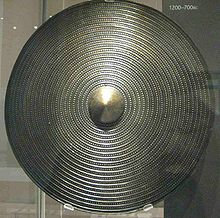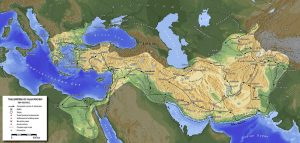The Bronze age was a time of change in terms of warfare; however, what changed was not necessarily tactics or how wars were fought, but instead a change of arsenal. In this period of human history, we see the creation of new a weapon, the use of bronze to enhance weapons that already existed. In terms of the additions, the newest weapon that was added to humanity’s arsenal in the Bronze age was the sword.

The first swords began to emerge around 1600 BCE, and many bronze age swords that have been recovered have a similar story to tell; one that speaks of heavy use in combat as seen by the damages in the blade and hilts as well as evidence of much resharpening and repair.1 In fact, one interesting discovery, which at first was rather strange, is that it has often been found that the damage on many of the swords that have been recovered typically have damage on only one side of the weapon; however, it was found that this was a shared trait among the many recovered swords. The answer to this mystery was not a hard one to find. Take for example a pencil; one will typically, without even noticing it, hold a pencil the same way every time one picks it up. After a while one may come to discover that the pencil will become dull, requiring it to be sharpened. The same thing will happen when using a sword; out of habit, the wielder will hold his sword the same way when striking or blocking while in combat, which will result in the dulling of the blade as well as the one-sided damage to the weapon requiring constant upkeep.2
All weapons share one thing in common: they are an extension of the human body. To elaborate, take for example the sword. A sword would be an extension of the arm allowing for a much greater attacking reach through slashing and thrusting movements. There is also one thing that swords, spears, and axes have in common. They can be used with one hand, and the obvious tool for the other hand would be a shield. It is understandable that one might just consider a shield as a piece of armor; but on the contrary, a shield is actually a defensive weapon, and when paired with a one-handed offensive weapon, the wielder could repeat a series of attack and defense maneuvers, such as slash and thrust then block or side step to avoid a blow, and repeat. One weapon by itself already enhances the human body’s capacity for combat, but add another, and at that one with defensive capabilities, and a skilled soldier becomes a one man army.
Shields came in many different shapes, sizes, and forms; the shield made of wood, for example was capable of taking hits and had a good resistance to blades. The leather shield was not much different from its wood counterpart though it was very light and more flexible; however, shields made of bronze had a much higher rate of survival than their organic made counterparts. They had much higher resistance to damage and breakage, ultimately leading to the wielder being in slightly less danger than if he were using lesser shields. Yet with the defensive advantage that bronze shields had over wood or leather came a slight drawback, a shared trait with any bronze weapon; they had additional weight to them.3 This additional weight would have hindered mobility just a bit compared to weapons not made of bronze, but that was a fair price to pay for a better defense and survival rate in the long run.
The bronze age would eventually come to an end, and weapons would be made of iron as the following era’s name suggests, the Iron Age. From this point on weapons would continue to evolve, warfare would be revolutionized by the Assyrians, the Greeks, and the Romans in the following age. However, one thing will always stay the same; that is that war would be a constant occurrence throughout human history for many reasons, and humanity’s ever growing arsenal would continue to expand.
- Barry Molloy, “For Gods or Men? A Reappraisal of the Function of European Bronze Age Shields,” Antiquity 83, no. 322 (December 2009): 1053. ↵
- K. Kristiansen, “The Tale of the Sword – Swords and Swordfighters in Bronze Age Europe,” Oxford Journal of Archaeology 21, no. 4 (November 2002): 323. ↵
- Barry Molloy, “For Gods or Men? A Reappraisal of the Function of European Bronze Age Shields,” Antiquity 83, no. 322 (December 2009): 1053-1055. ↵



34 comments
Troy Leonard
this was a very interesting article to read. I found it really interesting how high maintenance bronze was despite how weak it is compared to the other metals. i was unaware the weapons are extensions of the human body. you had great detail describing the way people fought and protected them selves and also how iron came along as a much stronger metal.
Cameron Ramirez
I have always had an interest on the different ages of history. The Bronze Age was the beginning of the advances in human resources. I found your article on the subject to be very informative and interesting. I found that the part on the swords being damaged on only one side to be very eye opening. I would have assumed the sword wielder would just hold the sword on its other side to take advantage of its sharpens rather than using the side that became dull. Overall I think that the topic you chose was great.
Manuel Aguilera
The appreciation of current weapons of today only reaches so far as they are more than likely the reason we may die if national war ensues. But with weapons of what I would consider more class, melee weapons, or weapons that just required more hand-to-hand combat in general, they can be appreciated more. Long range combat, which was introduced with firearms, never truly put the spirit of the warrior in a soldier, but swords, they brought out the gladiator in all those willing to put the life on the line for their countries. I feel that the upbringing/upgrading of melee weapons introduced a much more beautiful side of war, just as the article can argue. These weapons were an extension of man.
Karina Nanez
It was interesting to read about the different kinds of shields that existed before the bronze ones were invented. There wasn’t much variety but the wood and leather shields were definitely inventive, I’m also surprised they fared so well in battle, I would think those shields would be broken or useless as soon as battle begun. Regardless the was an interesting article and a good read.
Tyler Sleeter
Great article with lots of good information. It seems that advances in technology often bring about advances in weaponry and the Bronze Age was no difference. I found it interesting that swords were often only worn down on one side. The explanation makes perfect sense, but just one I never thought of before reading this article. I have heard before that the swords and other knife-type weapons are considered extensions of the human body, requiring a closeness in battle that is not seen in modern warfare.
Samman Tyata
It was a really interesting article to read. Swords were indeed one of the fiercest weapons ever built. I like that you have really good transitions between the pieces of your article. Weapons to be considered and mastered as a part of the human body really does sound authentic, looking back through history. Your examples were pretty convincing. Overall, it was a clear, informative, and interesting read.
Mariana Govea
Great article! It really helped me understand how the sword would become scratched due to your comparison with a pencil which totally makes sense and it helps us visualize what you meant better!As well as I liked how you said the people that used swords really loved them since it contributed to an extension of the human body which is a very good way of putting it since they do help you to fight and attack what you normally couldn’t do with just your hands!
Steven Clinton
Great article, the discovery of bronze impacted the whole scenery of warfare. The tools in the bronze age were way more efficient than years prior because of the sturdiness of bronze and the ability to sharpen worn bronze swords. In year’s before discovery, weapons were more flimsy and unusable after a sharp skirmish on the battlefield. This is a great article?
Nicolas McKay
This was a fantastic article Zander. You did a great job elaborating all of the aspects of weaponry, and the details you included of weapons were very interesting. Its crazy to think hat at one point those weapons were cutting edge, an having them meant the difference between victory and defeat. I would kind of like to see a follow up story about weapons from the iron age now.
Nahim Rancharan
It is interesting to see how the world had evolved into creating more technologically advanced and complex weapons than those that were originally made in the past. I like how this article manages to capture one of the many stages in history where humans were able to evolve and use a newfound resources to expand their technologies, in this case weapons, so as to increase their chances of survival. After reading this article, it is clear to me that the Bronze Age was a time in which many were able to accomplish great feats through the discovery of Bronze. Great Job highlighting the importance of the Bronze Age in your article!